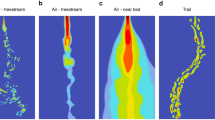Summary
The responses of the auditory ventral-cord neurons to stimulation with stridulatory songs and artificially generated sounds have been studied electrophysiologically. Tape recorded songs of the animals' own species (Fig. 1) and ofEphippiger ephippiger andHomorocoryphus nitidulus were used. Artificially generated stimuli were designed to simulateLocusta songs by appropriate amplitude-modulation of tones of various frequencies and of white noise.
The various ventral-cord neurons reflect in their responses different aspects of the temporal structure of the conspecific songs. Some neurons “count” the syllables in the song (Fig. 4); others give responses that follow the syllable-pair structure of the song. A third group gives tonic responses corresponding to the duration of the syllable pair (Fig. 10).
Habituating ventral-cord neurons respond differently to sounds comprising part of a series than they do when the sounds are isolated events. The G1-neuron in the habituated state encodes the syllable repetition rate of the conspecific song-that is, each single syllable elicits a one- or two-spike response. This form of response is brought about by a sort of optimization process depending on the conjunction of the conspecific syllable structure and repetition rate (Fig. 7).
Non-habituating neurons with tonic responses encode the intensity and duration of the syllables (Figs. 10 and 11). Since habituating G1-neurons and non-habituating C1-neurons transmit their responses to the same next-higher-level neuronal centers, the advantages of both types of coding can contribute to identification of conspecific songs at that level without time-consuming computation.
The causes of habituation in the auditory ventral-cord neurons are discussed.
Similar content being viewed by others
References
Bailey, W. J., Robinson, D.: Song as a possible isolating mechanism in the genusHomorocoryphus (Tettigonioidea, Orthoptera). Anim. Behav.19, 390–397 (1971)
Busnel, R. G.: On certain aspects of animal acoustic signals. In: Acoustic behavior of animals, (R. G. Busnel, ed.), p. 69–111. Amsterdam: Elsevier Publ. Co. 1963
Castellucci, V., Pinsker, H., Kupfermann, I., Kandel, E. R.: Neuronal mechanisms of habituation and dishabituation of the gill-withdrawal reflex inAplysia. Science167, 1745–1748 (1970)
Dubrovin, N. N., Zhantiev, R. D.: Acoustic signals of Katydids (Orthoptera, Tettigoniidae) [Russisch]. Zool. J. (Moskau)49, 1001–1014 (1970)
Elsner, N.: Neuroethology of sound production in gomphocerine grasshoppers (Orthoptera: Acrididae). I. Song patterns and stridulator movements. J. comp. Physiol.88, 67–102 (1974)
Elsner, N., Huber, F.: Neurale Grundlagen artspezifischer Kommunikation bei Orthopteren. Fortschr. Zool.22, 1–48 (1973)
Helversen, D. v.: Gesang des Männchens und Lautschema des Weibchens bei der FeldheuschreckeChorthippus biguttulus (Orthoptera, Acrididae). J. comp. Physiol.81, 381–422 (1972)
Kalmring, K.: The afferent auditory pathway in the ventral cord ofLocusta migratoria (Acrididae). I. Synaptic connectivity and information processing among the auditory neurons of the ventral cord. J. comp. Physiol.104, 103–141 (1975)
Kalmring, K., Römer, H., Rehbein, H. G.: Connections of acoustic neurons within the CNS of grasshoppers. Naturwissenschaften61, 454–455 (1974)
Kandel, E. R., Spencer, W. A.: Cellular neurophysiological approaches in the study of learning. Physiol. Rev.48, 65–134 (1968)
Rehbein, H. G., Kalmring, K., Römer, H.: Structure and function of acoustic neurons in the thoracic ventral nerve cord ofLocusta migratoria (Acrididae). J. comp. Physiol.95, 263–280 (1974)
Rehbein, H. G., Kalmring, K., Schwartzkopff, J.: Verschaltung eines akustischen Neurons im Bauchmark vonLocusta migratoria. Naturwissenschaften61, 689 (1974)
Rheinlaender, J., Kalmring, K.: Die afferente Hörbahn im Bereich des Zentralnervensystems vonDecticus verrucivorus (Tettigoniidae). J. comp. Physiol.85, 361–410 (1973)
Rowell, C. H. F., McKay, J. M.: An acridid auditory interneurone. II. Habituation, variation in response level and central control. J. exp. Biol.51, 247–260 (1969)
Stout, J. F., Huber, F.: Responses of central auditory neurons of female crickets (Gryllus campestris L.) to the calling song of the male. Z. vergl. Physiol.76, 302–313 (1972)
Suga, N.: Feature extraction in the auditory system of bats. In: Basic mechanisms of hearing (A. Møller, ed.), p. 675–744. New York: Academic Press Inc. 1973
Walker, T. J.: Specificity in the response of female tree crickets (Orthoptera, Gryllidae,) Oecanthinae) to calling songs of the males. Ann. entom. Soc. Amer.50, 626–636 (1957c
Zaretzky, M. D.: Specificity of the calling song and short term changes in the phonotacti, response by female cricketsScapsipedus marginatus (Gryllidae). J. comp. Physiol.79 153–172 (1972)
Author information
Authors and Affiliations
Additional information
Part of the program of the Sonderforschungsbereich 114 (Bionach) Bochum; supported by the Deutsche Forschungsgemeinschaft.
For generous support during this study, as well as for his critical reading of the manuscript and helpful suggestions, I thank Prof. J. Schwartzkopff. I am also grateful to Mr. R. Kühne and Dr. W. Papajewski for critical discussions of problems associated with this investigation. I thank Miss I. Klotz and Mr. R. Kühne for technical assistance.
Rights and permissions
About this article
Cite this article
Kalmring, K. The afferent auditory pathway in the ventral cord ofLocusta migratoria (Acrididae). J. Comp. Physiol. 104, 143–159 (1975). https://doi.org/10.1007/BF01379456
Received:
Issue Date:
DOI: https://doi.org/10.1007/BF01379456




